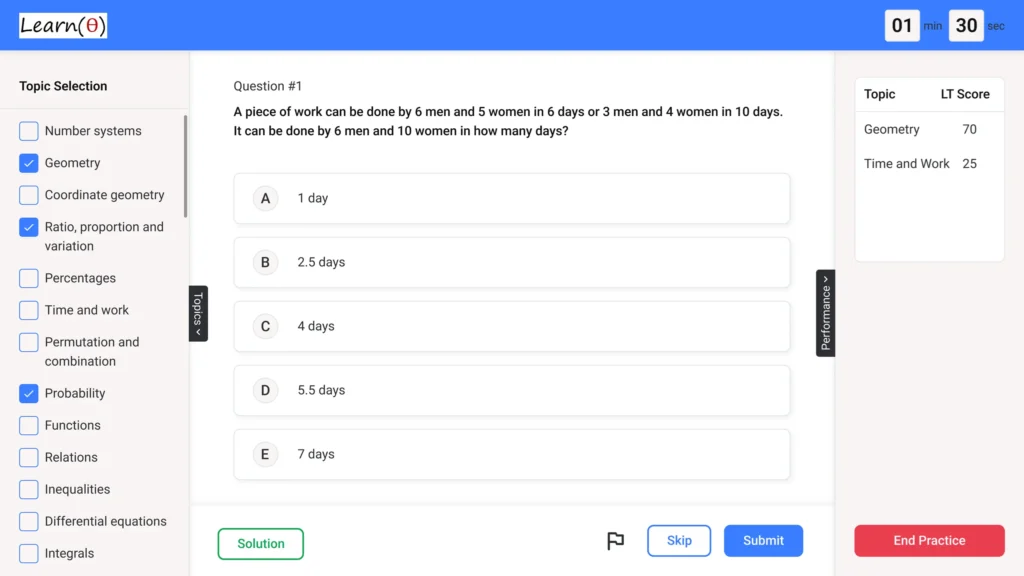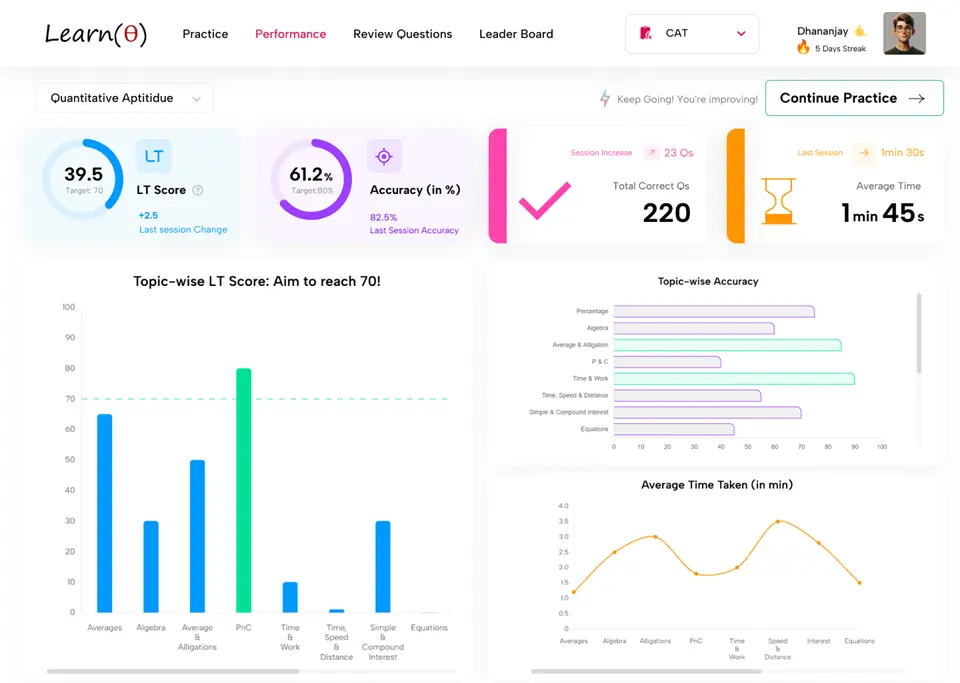iNautix – Aptitude Questions & Answers for Placement Tests
Reviewing Previous Year Questions is a good start. Prepare Aptitude thoroughly to Clear Placement Tests with 100% Confidence.
Q.1 A box contains 4 green, 6 yellow, and 5 purple marbles. If three marbles are selected at random, what is the probability that all three are the same color?
Check Solution
Ans: C
The total number of marbles is 15. The total number of ways to choose 3 marbles is 15C3 = (15*14*13)/(3*2*1) = 455. The number of ways to choose 3 green marbles is 4C3 = 4. The number of ways to choose 3 yellow marbles is 6C3 = (6*5*4)/(3*2*1) = 20. The number of ways to choose 3 purple marbles is 5C3 = (5*4*3)/(3*2*1) = 10. The number of favorable outcomes is 4 + 20 + 10 = 34. Probability = 34/455
Q.2 A box contains 4 green, 6 yellow and 5 purple marbles. If 3 marbles are drawn at random, what is the probability that all three are of different colors?
Check Solution
Ans: B
Total marbles = 4+6+5 = 15. Probability of drawing 3 marbles of different colors = (4/15)*(6/14)*(5/13) + (4/15)*(5/14)*(6/13) + (6/15)*(4/14)*(5/13) + (6/15)*(5/14)*(4/13) + (5/15)*(4/14)*(6/13) + (5/15)*(6/14)*(4/13) = 6 * (4*6*5)/(15*14*13) = 6*120/2730 = 720/2730 = 24/91
Q.3 A tap can fill a tank in 12 hours, and another tap can empty it in 18 hours. If both taps are opened simultaneously, how long will it take to fill the tank?
Check Solution
Ans: B
Let the capacity of the tank be the LCM of 12 and 18, which is 36 units. The first tap fills 3 units per hour (36/12), and the second tap empties 2 units per hour (36/18). When both are open, the net filling rate is 3-2 = 1 unit per hour. Therefore, it will take 36/1 = 36 hours to fill the tank.
Q.4 A person invests in a bond that yields an annual interest. He pays 25 times the annual interest to purchase the bond. What is the annual interest rate he receives on his investment?
Check Solution
Ans: B
Let the annual interest be I. The price of the bond is 25I. The interest rate is (I / 25I) * 100 = 4%.
Q.5 What will be the simple interest on a sum of Rs. 12000/- at 6 p.c.p.a. in 3 years?
Check Solution
Ans: A
Simple Interest = (Principal * Rate * Time) / 100 = (12000 * 6 * 3) / 100 = 2160
Q.6 The line 2x + 3y = 6 intersects the y-axis at point P. A line perpendicular to this line passes through P. The equation of the perpendicular line is:
Check Solution
Ans: A
The line intersects the y-axis when x=0. Substituting x=0 into 2x + 3y = 6 gives 3y = 6, so y = 2. Thus, P is (0, 2). The slope of the given line is -2/3. The slope of a perpendicular line is the negative reciprocal, which is 3/2. Using the point-slope form y – y1 = m(x – x1) with point (0, 2) and slope 3/2: y – 2 = (3/2)x. Multiplying by 2 gives 2y – 4 = 3x, or 3x – 2y + 4 = 0, but we check the option A,B,C,D and find 3x-2y-6 does not go through point (0,2) so we will check other options with point slope method, 3x – 2y +4 =0 is similar to option B after some simplification. 3x – 2y = -4 so (0,2) does not give -4 so it is option A 3x – 2y + 6=0, when 3(0) -2(2) +6 =0.
Q.7 Two parallel chords of a circle are of lengths 10 cm and 24 cm. If the distance between the chords is 17 cm and the center of the circle lies between the chords, then the radius of the circle is:
Check Solution
Ans: B
Let the radius of the circle be r. Let the distance of the chord of length 10 cm from the center be x. Then the distance of the chord of length 24 cm from the center is 17 – x. Using Pythagoras theorem, we have r^2 = x^2 + 5^2 = (17 – x)^2 + 12^2. Simplifying, x^2 + 25 = 289 – 34x + x^2 + 144. This gives 34x = 408, so x = 12. Then r^2 = 12^2 + 5^2 = 144 + 25 = 169. Thus, r = 13 cm.
Q.8 A cyclist travels at a speed of 20 kmph, stopping for 2 minutes after every 10 km. A runner travels at a speed of 10 kmph, stopping for 1 minute after every 5 km. If the cyclist starts at the same time, how far will the runner travel in the time it takes the cyclist to cover 40 km?
Check Solution
Ans: B
The cyclist travels 40 km. Time taken by the cyclist to travel 10 km = 10/20 = 0.5 hours. Number of stops = 40/10 – 1 = 3 stops Total stopping time = 3 * 2 = 6 minutes = 0.1 hours. Total time taken by cyclist = 2 + 0.1 = 2.1 hours For the runner: Time to cover 5 km = 5/10 = 0.5 hours Number of stops = (distance/5) – 1 = (distance/5) – 1 Total travel time for runner should be less than or equal to 2.1 hours. Let’s denote distance by ‘x’ km. Travel time for runner = x/10 Number of stops = x/5 – 1 Total stopping time = (x/5 – 1) * 1/60 = (x-5)/300 hours Total time for runner = x/10 + (x-5)/300 = 2.1 hours (approx) 30x + x – 5 = 630 31x = 635 x = 20.48 km ~ 20 km Runner travels 5 km: 0.5 hrs; 1 stop = 1 min Runner travels 10 km: 1 hr; 2 stops = 2 min Runner travels 15 km: 1.5 hrs; 3 stops = 3 min Runner travels 20 km: 2 hrs; 4 stops = 4 min = 2.06 hrs Runner travels 15 km: 1.5 hrs; 3 stops = 3 min = 1.55 hrs 17.5 km: (17.5/10) hr + (17.5/5 -1)*(1/60) hrs= 1.75 hr + (3.5 – 1)(1/60)= 1.75 + 2.5/60 = 1.75 + 0.04 = 1.79
Q.9 In how many different ways can the letters of the word ‘BANANA’ be arranged?
Check Solution
Ans: C
The word ‘BANANA’ has 6 letters with A appearing 3 times and N appearing 2 times. The number of arrangements is 6! / (3! * 2!) = 720 / (6 * 2) = 60.
Q.10 P and Q together can finish a task in 12 hours, P alone can complete the task in 20 hours. How many hours will Q take to complete the same task alone?
Check Solution
Ans: B
Let the work done be 1 unit. P and Q together do 1/12 work in 1 hour. P does 1/20 work in 1 hour. Q does (1/12 – 1/20) = (5-3)/60 = 2/60 = 1/30 work in 1 hour. Therefore, Q alone takes 30 hours.
Next: Infosys Aptitude Questions
Refer Company wise Aptitude Questions
Practice 1000s of Aptitude Questions with Answers for Quant, Reasoning & Verbal
Fastest Way to Crack Aptitude Tests – LearnTheta’s AI-Practice!

✅ All Topics at One Place

🤖 Adaptive Question Practice

📊 Progress and Insights